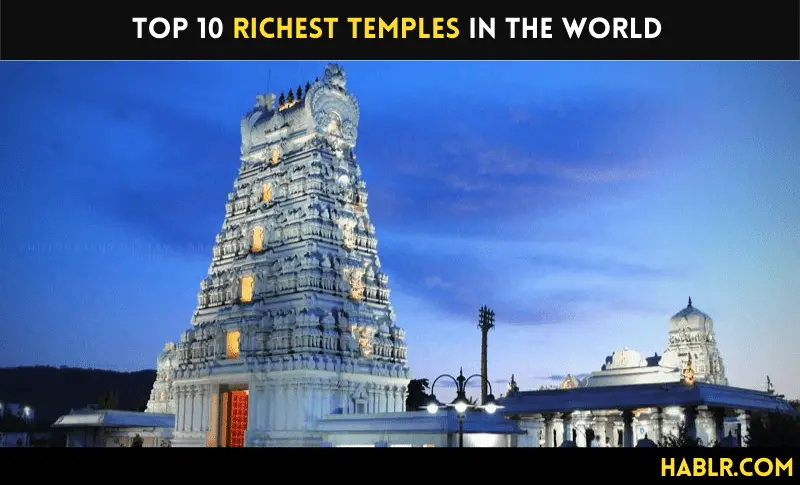
Temples are a place of importance for millions all over the world. When it comes to the richest temples in the world, India is at the very forefront. India has the richest temples ever made, and the largest number of pilgrims to support these temples. These temples will be sure to remain the richest in the decades to come, with gold embellishments, ornaments, silk garments, and exquisite structures.
It is only because of the pilgrims that these temples have flourished for millennia and more. The devotees uphold their faith in the gods and the temples that act as shrines for them. Many of these temples conduct a lot of charity work and provide food and shelter to the poor. Any trip to India is incomplete without a visit to these temples.
Gold, Gems, and Grandeur: The Most Opulent Temples on Earth
Table of Contents
1. Padmanabhaswamy Temple, Kerela, India
- Location: Thiruvananthapuram, Kerala, India
- Wealth: $20 Billion
- Trustee: Maharaja of Travancore, Moolam Thirunal Rama Varma
- Features: 1 main shrine, 4+ other shrines, 100-foot-tall structure.
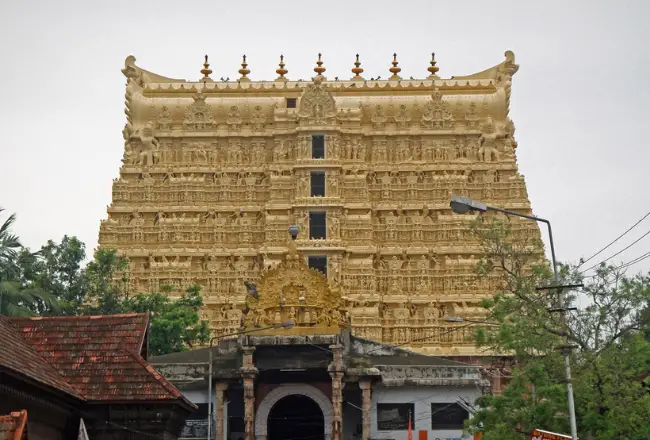
Translated literally as “The City of Lord Ananta or Vishnu”, this is the temple’s patron deity. Built in the 16th century with towering walls, the temple combines the architectural styles of the Chera and Dravidian cultures. Ananthapura temple in Kumbla in Kasaragod is regarded as the deity’s original seat, but it shares architectural similarities with the Adikesava Perumal temple in Thiruvattar, which is also considered the deity’s original seat. Padmanabhaswamy is the sacred deity of the royal family of Travancore.
In 2011, hordes of gold ornaments, expensive gems, etc. were discovered at the temple site raising its estimated value to 20 billion dollars. In 2020, it replaced Tirumala Tirupati Venkateshwar Temple as the wealthiest temple in India, as well as the world.
The Padmanabhaswamy Temple, located in Thiruvananthapuram, the capital city of the Indian state of Kerala, is renowned for its unimaginable wealth. This temple, dedicated to Lord Vishnu, is not only a spiritual abode but also a treasure trove of riches that have been accumulated over centuries. The temple’s immense wealth became widely known when the vaults within the temple were opened in 2011, revealing a staggering amount of gold, jewels, and rare artifacts.
The Padmanabhaswamy Temple boasts six vaults, with the contents of five vaults already being inventoried. The treasures discovered include gold idols, golden crowns, and precious gemstones worth billions of dollars. The temple’s immense wealth has attracted people from all over the world, eager to catch a glimpse of the opulence and grandeur contained within its walls.
2. Tirumala Tirupati Venkateshwar, Andhra Pradesh, India
- Location: Samadhi Mandir, Shirdi, Maharashtra, India.
- Wealth: $618 Million
- Trustee: Tirumala Tirupati Devasthanams (TTD)
- Features: 30 – 40 million pilgrims a year; most-visited holy place in the world; constructed in 300 AD.
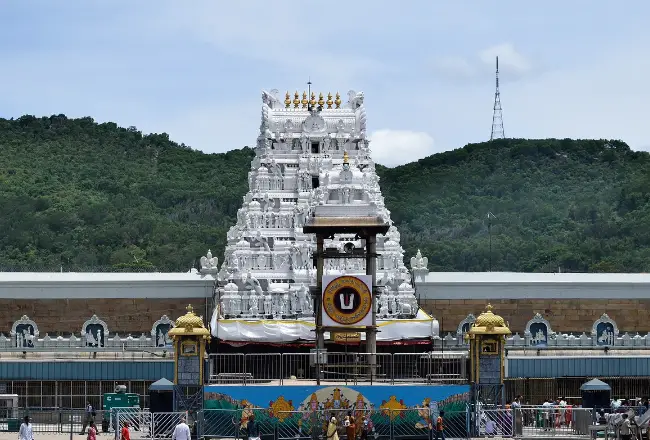
Venkateswara Temple is located at Tirumala, Tirupati, Chittoor district in Andhra Pradesh, India. A Vishnu avatar, Venkateswara, is said to have appeared here to save humanity from the hardships and sufferings of the Kali Yuga, according to legend. Daivam and Kaliyuga Prathyaksha Daivam are the names given to the region as a result of this.
The entire structure includes the Tirupati Temple and the Tirumala Shrine. There are other nicknames for Venkateswara, including Balaji and Govinda, that are used locally to refer to the deity. The government of Andhra Pradesh oversees the temple’s management trust. The Government of Andhra Pradesh also appoints the director of the trust. The income from the donations is used by the state to run administrative duties. The income is very high as the temple is one of the world’s richest temples.
3. Shirdi Sai Baba Temple, Maharashtra, India
- Location: Samadhi Mandir, Shirdi, Maharashtra, India
- Wealth: $274 Million
- Trustee: Shri Saibaba Sansthan Trust (SSST)
- Features: White marble, silver metal pillars, ornate designs.
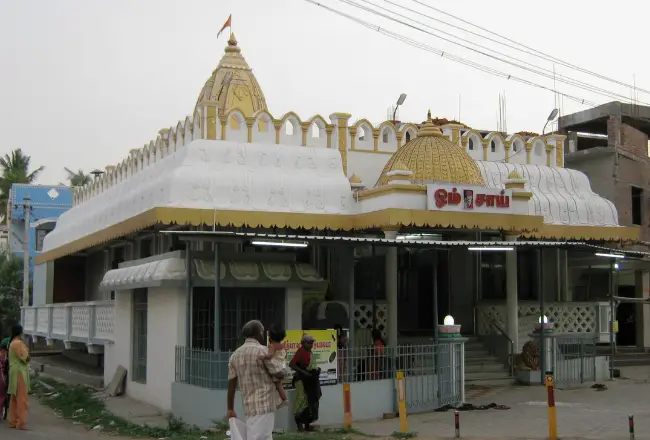
The temple is dedicated to Sai Baba, also known as Shirdi Sai Baba, an Indian spiritual teacher who is revered as a saint and a fakir by his devotees and is seen as a manifestation of Sri Dattaguru. During and after his lifetime, he was adored by both Hindu and Muslim worshippers.
Followers from all around the world visit this scenic temple. The location of the temple is in the very village where the Saint was said to have spent most of his time performing miracles, teaching, and assisting those in need. The Saint’s throne is composed of 94 kilograms of gold and the throne by itself has a value of millions, and all these factors make it one of the world’s richest temples.
4. Somnath Temple, Gujarat, India
- Location: Prabhas Patan, Veraval, Saurashtra, Gujarat
- Wealth: $123 million
- Trustee: Shree Somnath Mandir Trust (SSMT)
- Features: 150m alleviation, chairmanship retained by the Prime Minister of India.
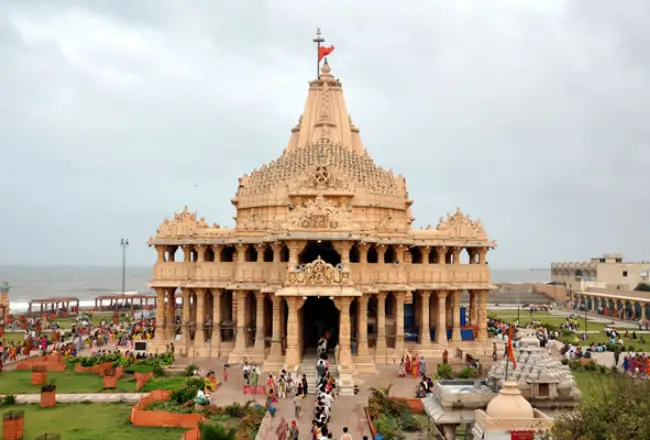
The Somnath temple on the western coast of Gujarat, India, is speculated to be the first of Lord Shiva’s twelve Jyotirlinga temples. It is a significant Hindu pilgrimage and tourism destination in India, particularly in Gujarat, and makes up a chunk of the tourism revenue generated by Gujarat. Even after being destroyed numerous times by invaders and rulers, the current mandir was restored to near perfection in the Chaulukya style of Hindu temple construction and finished in May 1951. The rebuilding began on the instructions of India’s first Home Minister, Vallabhbhai Patel, and was finished after his death.
The current chairman of the Shree Somnath Mandir Trust is India’s Prime Minister, Narendra Modi. This is one of the most important Jyotirlingam temples in India, dedicated to Lord Shiva. Several artworks were stolen and damaged within the shrine by the assailants, but the temple itself remains lovely. This key heritage site, located on Gujarat’s scenic west coast, attracts millions from all over the world each year, making it one of the world’s richest temples.
5. Vaishno Devi, J&K, India
- Location: Katra, Trikuta Hills, Jammu and Kashmir
- Wealth: $68 Million
- Trustee: Shri Mata Vaishno Devi Shrine Board
- Features: Has its own Statutory Act, one of the 108 mini-structures dedicated to Durga, visited by prominent saints like Vivekananda in Indian culture.
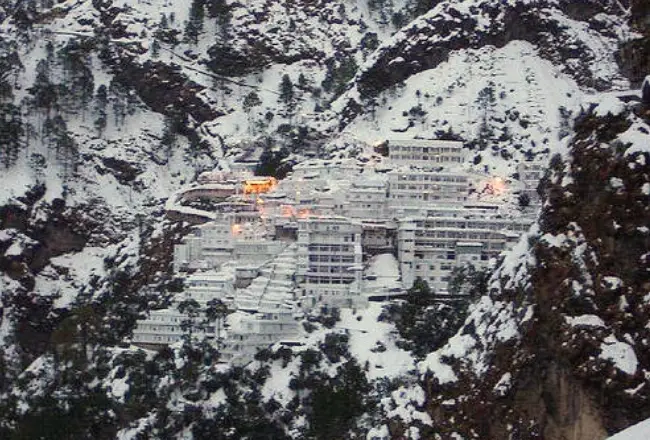
This one-of-a-kind piece of architecture may be found in Jammu and Kashmir, at an elevation of 5300 feet above sea level. It is one of the country’s oldest temples and is associated with the legend of Lord Shiva. Vaishno Devi Temple is supposedly one of the fifty-one places where fragments of Goddess Shakti’s corpse fell when Lord Shiva carried her dead body around the world.
The altitude and the rugged route make the entry into this temple extremely tedious; however, the same is bound to pay off. Not to mention the availability of ponies, helicopters, and palanquins at your disposal to reach the temple lest you tire out. Its hilly location does not deter thousands of visitors, local and foreign, from visiting the temple every year. The donations raked in make it one of the richest temples.
6. Sabarimala Temple, Kerela, India
- Location: Perinad Village, Pathanamthitta district, Kerala, India
- Wealth: $34 million
- Trustee: Travancore Devaswom Board (TDB)
- Features: Altitude of 1260m, 40 to 50 million devotees visiting every year, magnificent edifices with gold embellished structures.
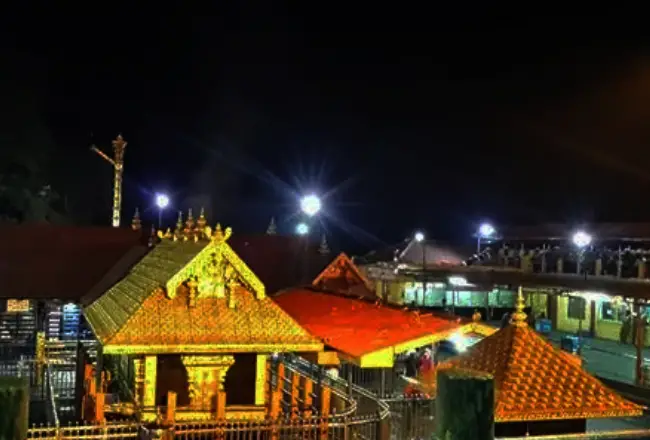
The Sabarimala Temple is a temple complex on Sabarimala hill within the Periyar Tiger Reserve in Perinad Village, Pathanamthitta district, Kerala, India. It is one of the world’s busiest yearly pilgrimage locations, with an estimated 40 to 50 million worshippers coming each year. The temple is devoted to Ayyappan, also known as Dharma Shasta, a Hindu Brahmachari or the god of celibacy who is said to be the son of Shiva and Mohini, the feminine manifestation of Vishnu. Sabarimala’s traditions are a synthesis of Shaivism, Vaishnavism, and other faiths.
Lord Ayyappan’s famed temple is situated on a small hill 3000 feet above sea level. Anyone who is considered competent in accessing the temple’s core sanctuary must undertake 41 days of rituals, including the loss of all worldly pleasures. Women of reproductive age are not permitted to enter the temple’s main shrine. Offerings and donations made by pilgrims are one of the temple’s main sources of income and are enough to make it one of the world’s richest temples.
7. Prem Mandir, Uttar Pradesh, India
- Location: Vrindavan, Uttar Pradesh, India.
- Wealth: Undisclosed; valued at $23 million.
- Trustee: Jagadguru Kripalu Parishat
- Features: The structure, which stands 125 feet tall and is built of solid Italian marble, took about 1000 artisans about 12 years to complete.
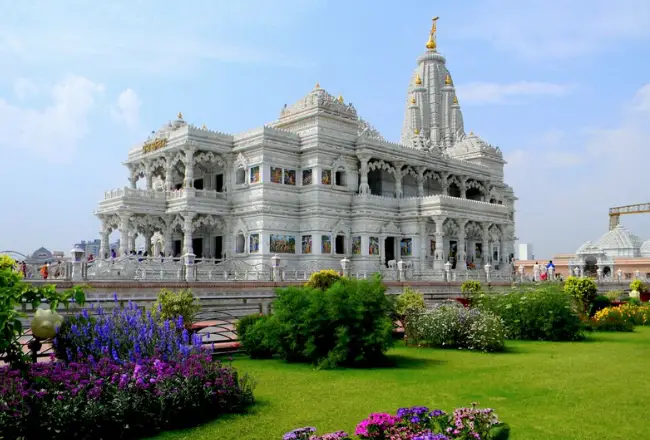
Prem Mandir, which translates to “the shrine of love” is a heavenly temple and one of the most famous tourist sites in Vrindavan. This religious complex is dedicated to Sri Krishna and Sita Ram’s stunning architectural magnificence, as well as the history of Sanatana Dharma. It is constructed in brilliant white marble.
You may spend a day in this 54-acre sacred chamber admiring the magnificent figurines of Sri Krishna and his devotees in the main temple. However, there is plenty to do in and around the temple. This alluring holy edifice in Uttar Pradesh is a must-see on a trip to the subcontinent. Aside from the main temple itself, the locality consists of intricate sculptures around the temple displaying painstaking inlay work.
8. Juggernaut or Jagannath Temple, Odisha, India
- Location: Puri, Odisha
- Wealth: $20 million
- Trustee: Kishore Chandra Patnaik
- Features: 120 temples and shrines, curvilinear structure, 65m in height.

This is one of the earliest temples dedicated to Lord Vishnu in India. Every year, a significant number of people visit the Jagannath temple in Puri, Orissa, notably during the Rath Yatra event. This is Orissa’s most important and profitable pilgrimage destination. The official net worth of the temple has yet to be announced, but speculation has already begun.
During important cultural events, the deity is said to have been richly decked, with 209kgs of gold ornaments and such. Furthermore, five underground rooms of this temple have yet to be found, and no one knows the true value of the complex.
9. Siddhivinayak Temple, Mumbai, India
- Location: Mumbai, India
- Wealth: $17 million
- Trustee: Shree Siddhivinayak Ganapati Mandir Trust (SSGMT)
- Features: A hall, a sanctum sanctorum, some free open space, and a distinctive multiangular, six-story building comprising an ancient architectural style.
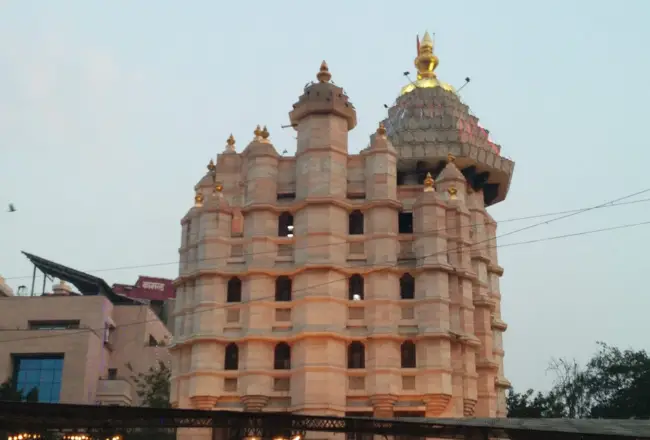
Mumbai is a grand witness to popular and archaeologically significant places of worship and historical importance. The Siddhivinayak temple in Mumbai, dedicated to Lord Ganesha, is one of the country’s most well-known temples. It draws a significant number of celebrities, ranging from Bollywood stars to business moguls. According to statistics, the temple receives around 125 crores each year in donations, including substantial sums from affluent residents of the city.
Lord Ganesha or Shree Ganesh is said to be the first to be worshipped before commencing any new endeavor or enterprise since he is the remover of obstacles and bad fortune. This is the Shree Siddhivinayak Ganapati Temple in Prabhadevi, Mumbai, a two-century-old temple where devotees pray to have their wishes granted. Mumbai, the city of dreams, seems like an apt destination for the temple.
10. Kashi Vishwanath Temple, Uttar Pradesh, India
- Location: Vishwanath Gali, Uttar Pradesh, India
- Wealth: $10 million
- Trustee: Sri Rameswar Puri
- Features: Holiest Shiva temple, located in one of the oldest cities of the world, 250 feet in height.
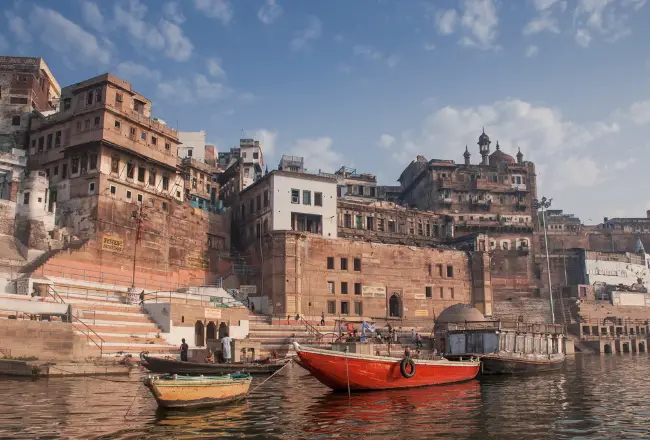
The Kashi Vishwanath Temple, dedicated to Lord Shiva, is a well-known Hindu temple. It is located in Vishwanath Gali, Varanasi, Uttar Pradesh, India. The Temple is one of the twelve Jyotirlingas, or holiest Shiva Temples, and is located on the western bank of the sacred Ganga.
Vishvanath or Vishveshvara, essentially meaning Lord of the Universe, is the main deity worshipped here. Kashi is another name for Varanasi. The Temple has long been mentioned as a central component of Shaiva worship in Hindu literature.
Criteria for determining the richest temples
To determine the richest temples in the world, several factors are taken into consideration. These factors include the value of the temple’s assets, such as gold, silver, and precious gemstones, as well as the land holdings and the historical significance of the temple. Additionally, the donations and offerings made by devotees over the years also contribute to the overall wealth of a temple. Combining these factors, a list of the top 5 richest temples has been compiled, showcasing the temples that possess the most opulent treasures.
From Ancient Altars to Modern Marvels: Richest Temples Across Time
The Angkor Wat in Cambodia
The Angkor Wat, located in Siem Reap, Cambodia, is not only a UNESCO World Heritage Site but also one of the richest temples in the world. This sprawling temple complex is a magnificent example of Khmer architecture and is considered the largest religious monument in the world. Built in the 12th century, the Angkor Wat is dedicated to the Hindu god Vishnu, but it later transformed into a Buddhist temple.
The Angkor Wat’s wealth extends beyond its architectural grandeur. The temple’s vast land holdings, coupled with the donations made by devotees, have contributed to its immense wealth. The temple complex is surrounded by lush forests and is home to numerous ancient temples and structures. Its historical significance and cultural value have made the Angkor Wat a must-visit destination for travelers seeking to witness the opulence of this ancient temple.
The Meenakshi Amman Temple in India
Located in Madurai, Tamil Nadu, the Meenakshi Amman Temple is a testament to the wealth and grandeur of ancient India. This temple, dedicated to Goddess Meenakshi, is renowned for its intricate carvings, colorful sculptures, and majestic towers. The temple complex is spread over an area of 45 acres and is home to numerous shrines and halls.
The Meenakshi Amman Temple’s opulence is not limited to its architectural beauty. The temple possesses vast land holdings and receives a significant amount of donations from devotees. The annual Meenakshi Thirukalyanam festival, celebrating the divine marriage of Goddess Meenakshi and Lord Shiva, attracts millions of devotees, contributing to the temple’s wealth. The temple’s wealth is used for the maintenance and renovation of the temple complex as well as for various charitable activities.
The Golden Temple in India
The Golden Temple, also known as Sri Harmandir Sahib, is the holiest Gurudwara and one of the richest temples in the world. Located in Amritsar, Punjab, India, this magnificent temple is a symbol of Sikhism’s rich heritage and devotion. The temple is covered in gold, giving it a mesmerizing appearance, especially when its reflection shimmers in the surrounding Amrit Sarovar (Pool of Nectar).
The Golden Temple’s wealth comes from the donations made by devotees, both in cash and in kind. The temple’s langar (community kitchen) serves free meals to thousands of visitors every day, funded entirely by donations. The temple’s immense wealth is utilized for various charitable activities, including providing education, healthcare, and food to those in need.
The Borobudur Temple in Indonesia
The Borobudur Temple, located in Central Java, Indonesia, is one of the most famous Buddhist temples in the world and a UNESCO World Heritage Site. This ancient temple, built in the 8th century, is a marvel of architectural and artistic excellence. The temple’s design incorporates intricate stone carvings and stupas, representing the path to enlightenment in Buddhism.
While the exact wealth of the Borobudur Temple is not publicly disclosed, it is known that the temple receives significant donations from devotees and tourists. The temple’s historical significance and spiritual aura attract visitors from all over the world, contributing to its wealth. The funds generated are used for the maintenance and preservation of the temple, ensuring that future generations can continue to marvel at its beauty.
Controversies surrounding temple wealth
The immense wealth possessed by these temples has not been without controversies. Questions have been raised about the transparency and management of temple funds. Some argue that the wealth should be utilized for the betterment of society, while others believe that it should be preserved as a testament to the rich cultural heritage of these temples.
Efforts have been made to strike a balance between preserving the temples’ heritage and utilizing the wealth for charitable purposes. Many of these temples have established trust funds and foundations to manage and allocate the funds for various social and humanitarian initiatives.
Impact of temple wealth on local communities
The wealth of these temples also has a significant impact on the local communities. The influx of tourists and devotees contributes to the local economy, creating jobs and opportunities for businesses in the surrounding areas. Additionally, the temples often engage in philanthropic activities, providing healthcare, education, and other social services to the local communities.
However, there are also concerns about the disparity in wealth distribution and the potential exploitation of local resources. It is crucial to ensure that the benefits of temple wealth reach all sections of society and that the local communities are involved in decision-making processes regarding the utilization of these funds.
Conclusion and final thoughts
These richest temples in the world offer a glimpse into a world of unimaginable wealth and grandeur. These temples, with their opulent treasures and architectural magnificence, have captivated the hearts and minds of people for centuries. The wealth they possess is not merely a symbol of material opulence but also a testament to the devotion and patronage of countless worshipers.
While controversies surround the wealth of these temples, efforts are being made to strike a balance between preserving their cultural heritage and utilizing the funds for the betterment of society. The impact of temple wealth on local communities can be significant, but it is vital to ensure that the benefits are shared equitably and sustainably.
As you explore these temples, let their splendor and rich history inspire you. Witness the intersection of religion, history, and boundless riches, and appreciate the artistry and devotion that have shaped these sacred places.

